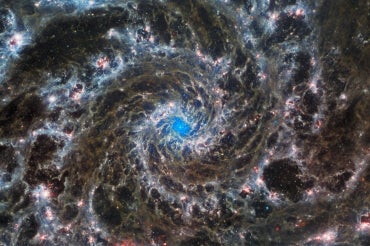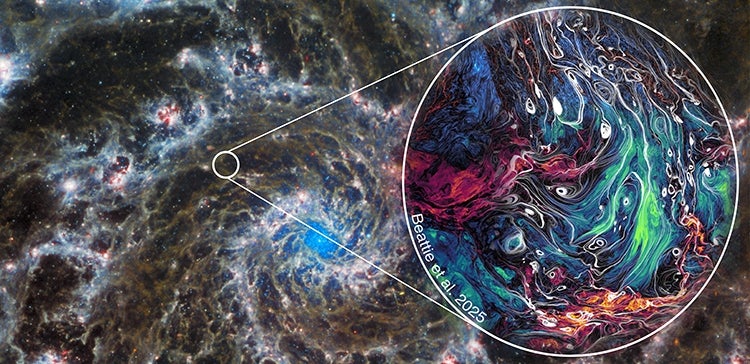Researchers develop new model to explore 'unsolved' phenomenon of turbulence

The Phantom Galaxy (M74) as seen by the James Webb Space Telescope (photo by ESA/Webb, NASA & CSA, J. Lee and the PHANGS-JWST Team)
Published: May 26, 2025
Turbulence can be found everywhere – from the contents of a coffee cup to intergalactic space.
But for scientists, it’s also a bit of a mystery.
“Turbulence remains one of the greatest unsolved problems in classical mechanics,” says James Beattie, a postdoctoral researcher at the Canadian Institute for Theoretical Astrophysics in the University of Toronto’s Faculty of Arts & Science, who also holds a joint appointment at Princeton University. “This despite the fact that turbulence is ubiquitous: from swirling milk in our coffee to chaotic flows in the oceans, solar wind, interstellar medium – even the plasma between galaxies.
“The key distinction in astrophysical environments is the presence of magnetic fields, which fundamentally alter the nature of turbulent flows,” he says.

Beattie is lead author of a new paper in the journal Nature Astronomy describing the computer simulation he and collaborators have developed to study, in unprecedented detail, magnetism and turbulence in the interstellar medium (ISM) – the vast ocean of gas and charged particles that lies between stars in the Milky Way galaxy.
The model is the most powerful to date, requiring the computing capabilities of the SuperMUC-NG supercomputer at the Leibniz Supercomputing Centre in Germany.
It directly challenges our understanding of how magnetized turbulence operates in astrophysical environments. Beattie is hopeful it will provide new insights into the ISM, the magnetism of the Milky Way Galaxy as a whole, and astrophysical phenomena such as star formation and the propagation of cosmic rays.
“This is the first time we can study these phenomena at this level of precision and at these different scales,” says Beattie.
The paper was co-authored with researchers from: Princeton University; Australian National University; the Australian Research Council Center of Excellence in All-Sky Astrophysics; Universität Heidelberg; the Center for Astrophysics, Harvard & Smithsonian; Harvard University; and the Bavarian Academy of Sciences and Humanities.

While there are far fewer particles in interstellar space than in ultra-high vacuum experiments on Earth, their motions are sufficient to generate a magnetic field – much like how the motion of Earth’s molten core generates our planet’s field.
And although the galactic magnetic field is millions of times weaker than a fridge magnet, it remains one of the forces that shapes the cosmos.
At its largest scale, the model can improve our understanding of the Milky Way’s overall magnetic field. When scaled down, it can help astronomers better understand more “compact” processes, such as the solar wind that streams outward from the sun and greatly affects Earth.
Thanks to its higher resolution, the model also has the potential to deepen our understanding of star formation. "We know that magnetic pressure opposes star formation by pushing outward against gravity as it tries to collapse a star-forming nebula,” says Beattie. “Now we can quantify in detail what to expect from magnetic turbulence on those kinds of scales.”
In addition to its higher resolution and scalability, the model also marks a significant advance by simulating the dynamic changes in the density of the ISM – from an incredibly tenuous near-vacuum to the higher densities found in star-forming nebulas.
“What our simulation captures really well,” says Beattie, “is the extreme changes in density of the ISM – something previous models hadn't taken into account.”
As he develops the next generation of the model with even higher resolution, Beattie is testing it against data collected from observations of the sun-Earth system.
“We've already begun testing whether the model matches existing data from the solar wind and the Earth – and it’s looking very good,” says Beattie. “This is very exciting because it means we can learn about space weather with our simulation. Space weather is very important because we’re talking about the charged particles that bombard satellites and humans in space and have other terrestrial effects.”
Beattie says the new model arrives at a time of growing interest in astrophysical turbulence, alongside a surge in observations of the ISM. As new instruments such as the Square Kilometre Array (SKA) Observatory come online – with the ability to measure fluctuations in turbulent magnetic fields across the galaxy in great detail – accurate theoretical frameworks for interpreting magnetic turbulence will become even more critical.
One of the things that draws Beattie to this research is its elegant consistency.
"I love doing turbulence research because of its universality,” he says. “It looks the same whether you’re looking at the plasma between galaxies, within galaxies, within the solar system, in a cup of coffee or in Van Gogh’s The Starry Night.
“There’s something very romantic about how it appears at all these different levels and I think that’s very exciting.”



